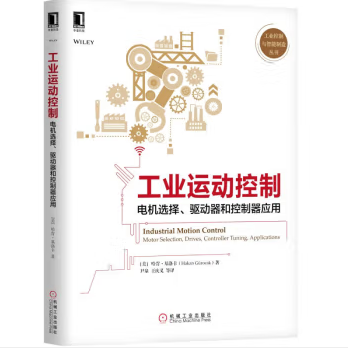
Book Features
Content Summary
Author Profile
Translator’s PrefaceForewordChapter 1 Introduction1.1 Components of Motion Control Systems1.1.1 Human-Machine Interface1.1.2 Motion Controller1.1.3 Driver1.1.4 Actuator1.1.5 Transmission Mechanism1.1.6 FeedbackReferencesChapter 2 Motion Curves2.1 Basic Concepts of Kinematics2.2 Common Motion Curves2.2.1 Trapezoidal Velocity Curve2.2.2 S-Curve Velocity Curve2.3 Multi-Axis Motion2.3.1 Swing Motion2.3.2 Interpolation MotionExercisesReferencesChapter 3 Drive Chain Design3.1 Inertia and Torque Conversion3.1.1 Gearbox Ratio3.1.2 Inertia Conversion3.1.3 Torque Conversion3.1.4 Efficiency3.1.5 Total Inertia3.2 Inertia Ratio3.3 Transmission Mechanisms3.3.1 Torque and Inertia Conversion of Transmission Mechanisms3.3.2 Pulleys3.3.3 Lead Screws3.3.4 Rack and Pinion Transmission3.3.5 Belt Transmission in Linear Motion3.3.6 Conveyors3.4 Calculation of Motion Torque3.4.1 Acceleration (Maximum) Torque3.4.2 Operating Torque3.4.3 Deceleration Torque3.4.4 Continuous (Effective Value) Torque3.5 Mechanical Characteristics of Motors3.5.1 Mechanical Characteristic Curves of AC Servo Motors3.5.2 Mechanical Characteristic Curves of AC Induction Motors3.6 Motor Selection3.7 Direct Drive Motor Selection3.8 Motor and Transmission Mechanism Selection3.9 Gearbox3.9.1 Planetary Servo Reducer3.9.2 Worm Gear Reducer3.10 Selection of Servo Motors and Gear Reducers3.11 Selection of AC Induction Motors and Gearboxes3.12 Selection of Motors, Gearboxes, and Transmission MechanismsExercisesReferencesChapter 4 Motors4.1 Basic Concepts4.1.1 Electrical Cycle and Mechanical Cycle4.1.2 Three-Phase Windings4.2 Rotating Magnetic Field4.2.1 Hall Sensors4.2.2 Six-Step Commutation Method4.3 AC Servo Motors4.3.1 Rotor4.3.2 Stator4.3.3 Sine Wave Commutation4.3.4 Torque Calculation for Sine Wave Commutation4.3.5 Six-Step Commutation Method for AC Servo Motors4.3.6 Motor Phasing Using Encoders and Hall Sensors4.4 AC Induction Motors4.4.1 Stator4.4.2 Rotor4.4.3 Operation of Motors4.4.4 Direct Grid Constant Speed Operation4.4.5 Variable Speed Operation with Frequency Drives4.5 Mathematical Models4.5.1 AC Servo Motor Model4.5.2 AC Induction Motor ModelExercisesReferencesChapter 5 Sensors and Control Devices5.1 Photoelectric Encoders5.1.1 Incremental Encoders5.1.2 Sine/Cosine Encoders5.1.3 Absolute Encoders5.1.4 Serial Communication of Encoders5.1.5 Speed Estimation5.2 Detection Sensors5.2.1 Limit Switches5.2.2 Proximity Sensors5.2.3 Photoelectric Sensors5.2.4 Ultrasonic Sensors5.2.5 Concepts of Fan-In and Fan-Out5.2.6 Three-Wire Sensors5.3 Command Control Devices5.3.1 Buttons5.3.2 Selector Switches5.3.3 Indicator Lights5.4 Control Devices for AC Induction MotorsExercisesReferencesChapter 6 AC Drives6.1 Drive Circuits6.1.1 Rectifiers and DC Links6.1.2 Inverters6.2 Basic Control Structures6.2.1 Cascaded Speed and Position Loops6.2.2 Single-Loop PID Position Control6.2.3 Cascaded Closed Loop with Feedforward Control6.3 Inner Loops6.3.1 Inner Loop for AC Induction Motors6.3.2 Inner Loop for AC Servo Motors6.4 Simulation Models of Controllers6.4.1 Simulation Models for Vector Control of AC Induction Motors6.4.2 Simulation Models for Vector Control of AC Servo Motors6.5 Parameter Tuning6.5.1 Parameter Tuning for PI Controllers6.5.2 Parameter Tuning for PID Position Controllers6.5.3 Parameter Tuning for Cascaded Speed/Position Controllers with Feedforward GainExercisesReferencesChapter 7 Motion Controller Programming and Applications7.1 Motion Modes7.1.1 Linear Motion7.1.2 Arc Motion7.1.3 Contour Motion7.2 Programming7.2.1 Motion Programs7.2.2 PLC Functions7.3 Single-Axis Motion7.3.1 Jogging7.3.2 Homing7.4 Multi-Axis Motion7.4.1 Multi-Motor Single Axis Drive7.4.2 Two-Axis or Multi-Axis Coordination7.4.3 Master-Slave Synchronous Tracking7.4.4 Tension Control7.4.5 KinematicsExercisesReferencesAppendix Overview of Control TheoryUnit Conversion Table
